中职英语unit2friend and friendship--writing教案
- 格式:doc
- 大小:34.00 KB
- 文档页数:2


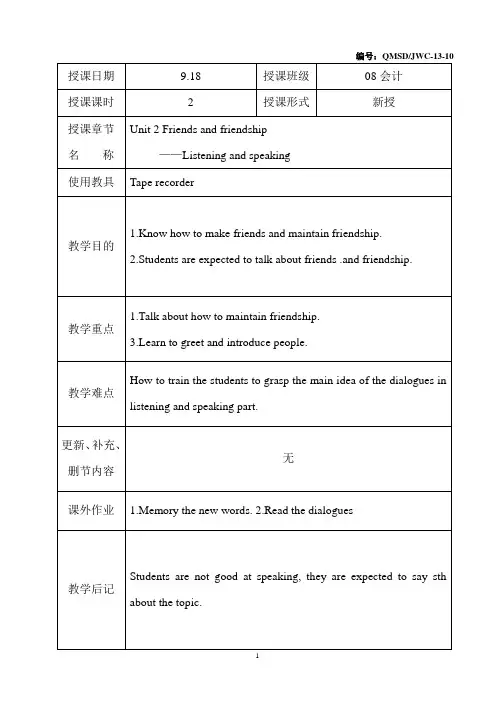
编号:QMSD/JWC-13-10授课主要内容和板书设计Lead-in.T: Do you have friends? What is your friend like?T: Can you give some words to describe him /her?New lectureStep 1. Learn the new words.1.take away 带走,移开eg. You’d better take away your bike every day.2.count on 依靠,指depend on/rely oneg. Many parents wish that they can count on their children in the future.Can I count on you to help me?3.go for a walk 散步eg.I like going for a walk after supper.4.make up 编造,虚构编造,虚构eg. We often make up dialogues in class.弥补,补足eg. He wanted to make up the missed lessons.组成eg. The medical team is made up of ten doctors.整理(房间等),准备(床铺等)She made up a bed before she went out.下(决心)make up one’s mindWe have made up our minds.化妆,打扮She made up before she went out.A little way off 不久的将来;在不远处That’s a little way off.Step 2 Listening1.pre-reading :Ask Ss to skip the questions of the listening part and guess themain idea about the dialogue.2.while-listening : Listen to the tape and finish the questions.3.post-listening : Check the answer.Step 3.Speaking1.Read the dialogue and try to find out how to greet and introduce people.2.Ask Ss to perform the dialogue according to the text.Some useful expressions:Greetings FarewellsMorning! Bye byeHello/Hi! So longGood morning/afternoon/evening! See youHow are you? I’ll be seeing you.Good to meet you. Take care.How is everything? Nice meeting you.How do you do?Introducing peopleMay I introduce …?Allow me to introduce Mr. .. to you?Mr..,let me introduce Mr. to you.I’d like you to meet my friend…Miss…,this is Mr…Work in pairs or groups and take turns to make introductions in the following situations.Exercise:Practice dialoguesConclusion:1.Improve the Ss’s listening and speaking ability.2.Encourage Ss to talk freely.HomeworkMemory the new words.编号:QMSD/JWC-13-10授课主要内容和板书设计Lead-in1.who is your best friend?2.How long have you been friends?3.What do you do to keep your friendship?Discuss the questions with your partnerNew lectureStep 1.Learn the new words1.maintain vt.保持;维持eg. We should maintain friendly relations with neighboring countries.Maintain law and order 维护法律和秩序Maintain good relationship维持良好的关系Maintain world peace维持世界和平Maintain one’s health保持健康Maintain friendly relations with sb.2.patient a.有耐心的More ~ most~Be patient with sb./ be patient of sb.eg.You should be more patient with others.你应该多容忍他人一些。
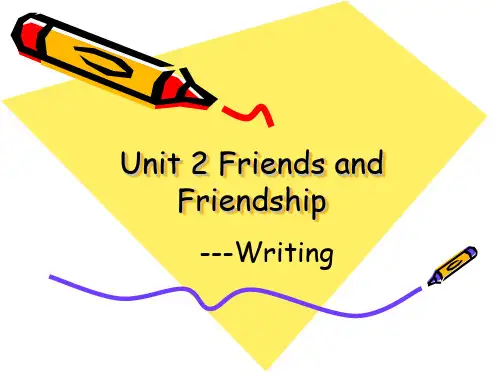


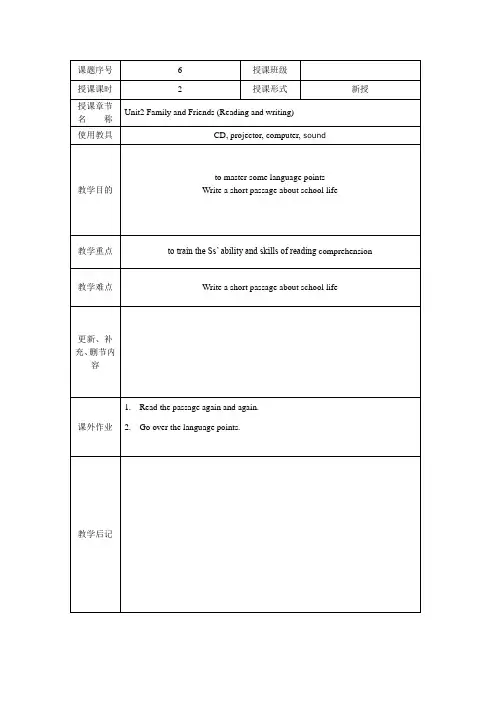
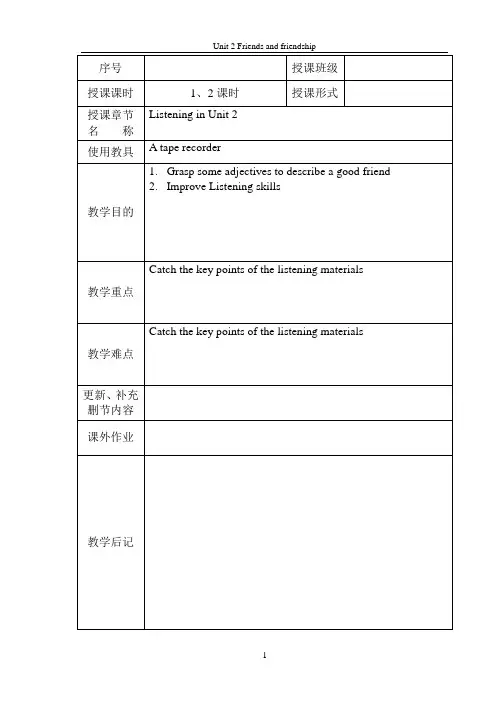
Step 1. Greetings.Step 2. Free talk.Do you have any friends in our school?Do you think they are your good friends?What’s your friend like? Can you give some words to describe her/him? (Ask some students to write their answers on the blackboard)Step 3. Work in pairs to discuss what qualification a good friend should have except the appearance.patient, kind, honest* A friend in need is a friend indeed.Step 4. New words and expressions.* humorous a.* buddy n.* brave a. braver-bravest* take away 带走,移开R: take the medicine take photos take one’s temperature take a seat take a walk take down take it easy take off take good care of take outIt takes sb. some time to do sth.* countcount on = rely on = depend one.g. Y ou can’t count on the weather being fine.If you have trouble, you can count on your parents.Y ou can count on me for everything in the future.* go for a walkShall we go for a walk?* skateboard n. 滑板R: blackboard* a little way off 不久的将来;在不远处R: on one’s way to all the way by the way in a way in no way(决不) in the way lose one’s way the Milky WayWhere there is a will, there is a way.* make up storiesmake up 虚构,编造,想象e.g. make up an excusemake up a plot for a novelThis story was partly true and partly made up.Step 5. Listening Task 1.Ⅰ.Pre-listening. ask students to look at the picture to guess what they willhear.Ⅱ. Skim the questions.Ⅲ. Listening. Ask students to finish the choice while listening.Ⅳ. After-listening. Ask students to discuss the answers and check them by listening again.Step 6. Task 2.Ⅰ. Pre-listening. Ask students to read the demands and know what to do. Ⅱ. Listening. Ask students to make choices while listening.Ⅲ. After-listening. Students discuss the answers and check them by listening again.Ⅳ. Listening and repetition.Ⅴ. Act out the dialogues.Step 7. Homework.Ⅰ. Copy and recite the new words and expressions.Ⅱ. Preview ―Speaking‖Step 1. Greetings.Step 2. Revision.Ⅰ. Review some points of Listening.Ⅱ. Act out the dialogues.Step 3. Brainstorming.Do you know how many kinds of ways to make greetings and introductions?Greetings Introducing peopleMorning. Miss…, this is…Hello. Hi. May I introduce…Good morning/afternoon/evening Allow me to introduce… to you. How are you (doing)? I’d like you to meet my friend…Good/Glad to meet you Mr. … let me introduce…How is everything?How do you do?Step 4. Task 1 in Speaking.Ⅰ. Read the following dialogue carefully and try to find out how to greet and introduce people.Ⅱ. Act out the dialogue.Step 5. Task 2.Work in groups and take turns to make introductions in the following situations.Situation 1: At your birthday party, you greet your old friends and introduce a new friend to them.Situation 2: Y ou’re visiting your friend when one of his classmates comes.Y ou are introduced to him by your friend.Situation 3: Y ou are a teacher. A new term begins. Y ou are to introduce a new comer to the class.Step 6. Practice.1.早晨与同学见面,谈论一下昨天作业完成情况。
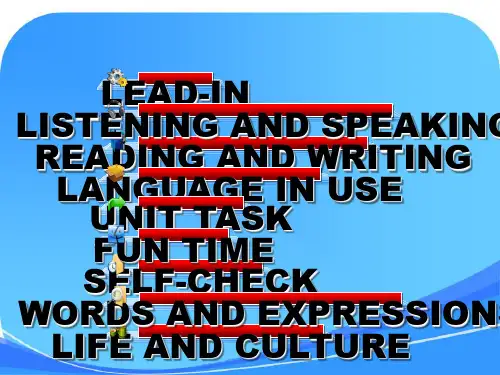
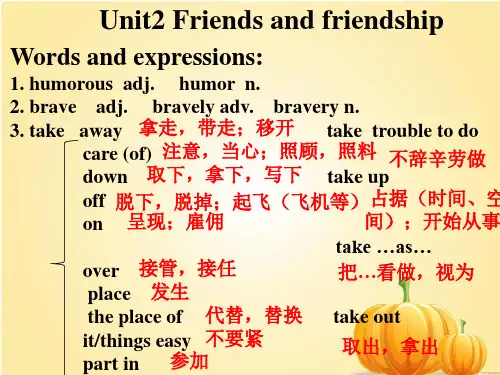
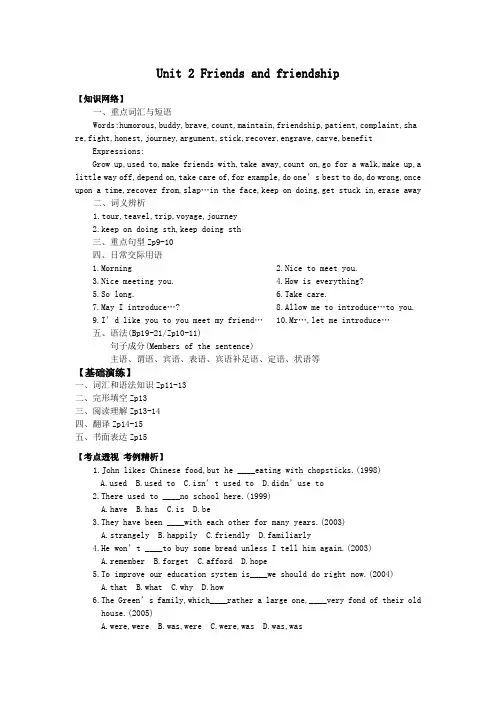
Unit 2 Friends and friendship【知识网络】一、重点词汇与短语Words:humorous,buddy,brave,count,maintain,friendship,patient,complaint,sha re,fight,honest,journey,argument,stick,recover,engrave,carve,benefit Expressions:Grow up,used to,make friends with,take away,count on,go for a walk,make up,a little way off,depend on,take care of,for example,do one’s best to do,do wrong,once upon a time,recover from,slap…in the face,keep on doing,get stuck in,erase away二、词义辨析1.tour,teavel,trip,voyage,journey2.keep on doing sth,keep doing sth三、重点句型Zp9-10四、日常交际用语1.Morning2.Nice to meet you.3.Nice meeting you.4.How is everything?5.So long.6.Take care.7.May I introduce…? 8.Allow me to introduce…to you.9.I’d like you to you meet my friend… 10.Mr…,let me introduce…五、语法(Bp19-21/Zp10-11)句子成分(Members of the sentence)主语、谓语、宾语、表语、宾语补足语、定语、状语等【基础演练】一、词汇和语法知识Zp11-13二、完形填空Zp13三、阅读理解Zp13-14四、翻译Zp14-15五、书面表达Zp15【考点透视考例精析】1.John likes Chinese food,but he ____eating with chopsticks.(1998)eded toC.isn’t used toD.didn’use to2.There used to ____no school here.(1999)A.haveB.hasC.isD.be3.They have been ____with each other for many years.(2003)A.strangelyB.happilyC.friendlyD.familiarly4.He won’t ____to buy some bread unless I tell him again.(2003)A.rememberB.forgetC.affordD.hope5.To improve our education system is____we should do right now.(2004)A.thatB.whatC.whyD.how6.The Green’s family,which____rather a large one,____very fond of their oldhouse.(2005)A.were,wereB.was,wereC.were,wasD.was,was7.The girl led the old woman____while crossing the street.(2007)A.by the armB.in the armC.by her armD.in her arm9.Tom said that he would go to see his grandma in the country____the nextweek.(2008)A.some timeB.some timesC.sometimeD.sometimes10.Mr.Wang is much f____(友好)than Mr.Yang.(2000)【能力拓展】(2006 Passage A)阅读下列短文,从每题所给的四个选项中,选出最佳选项。
中职生的交朋友英文作文Making friends as a vocational school student can be both challenging and exciting. In my experience, I've found that the best way to make friends is to be open-minded and approachable. Being friendly and showing genuine interestin others can go a long way in building connections.One important aspect of making friends is finding common interests. Whether it's sports, music, or hobbies, having something in common can create a bond between individuals. By joining clubs or participating in extracurricular activities, I have been able to meet like-minded people and form lasting friendships.Another way to make friends is by being a good listener. People appreciate when you take the time to listen to their thoughts and feelings. By showing empathy and understanding, you can create a safe space for others to share their experiences. This can help build trust and foster deeper connections.Sometimes, making friends requires stepping out of your comfort zone. It's important to be proactive and initiate conversations with new people. By introducing yourself and showing a genuine interest in getting to know them, you can break the ice and establish a connection. Don't be afraid to take the first step!In addition to being open-minded and approachable, it's also important to be yourself. Authenticity is key in forming meaningful friendships. Trying to be someone you're not will only lead to superficial connections. Embrace your unique qualities and let others appreciate you for who you truly are.Lastly, maintaining friendships requires effort and commitment. It's important to invest time and energy into nurturing these relationships. Whether it's through regular hangouts, checking in on each other, or supporting one another's goals, maintaining friendships requires mutual effort and understanding.Overall, making friends as a vocational school studentis all about being open-minded, approachable, and authentic. By finding common interests, being a good listener,stepping out of your comfort zone, and investing in relationships, you can build meaningful connections thatcan last a lifetime. So go out there, be yourself, and embrace the opportunity to make new friends!。
中职英语友谊作文模板Title: Friendship in Vocational English。
Friendship is an important part of our lives, and it plays a crucial role in our personal and professional development. In the context of vocational English, friendship can greatly enhance our learning experience and help us grow both academically and personally.First and foremost, friendship in vocational English creates a supportive and encouraging environment for learning. When students form strong bonds with their classmates, they are more likely to feel comfortable expressing themselves and participating actively in class. This leads to a more dynamic and engaging learning atmosphere, where students are not afraid to make mistakes and learn from each other. In addition, friends can help each other with homework, practice speaking and listening, and provide moral support during challenging times. This mutual assistance and encouragement can significantly improve students' language skills and overall learning outcomes.Furthermore, friendship in vocational English fosters cultural understanding and appreciation. In a vocational English class, students come from diverse backgrounds and have different experiences and perspectives. By building friendships with classmates, students have the opportunity to learn about different cultures, traditions, and customs. This not only enriches their language learning experience but also promotes tolerance, empathy, and open-mindedness. As a result, students become more culturally competent and better prepared to communicate and collaborate in a globalized world.Moreover, friendship in vocational English can lead to valuable networking opportunities. In today's competitive job market, having a strong professional network is essential for career advancement. By forming friendships with classmates, students can expand their social and professional circles, which may lead to potential job opportunities, internships, or collaborations in the future. Additionally, friends can provide valuable advice, mentorship, and recommendations, which can be instrumental in students' careerdevelopment. Therefore, friendship in vocational English not only enriches students' learning experience but also contributes to their future success in the workplace.In conclusion, friendship in vocational English is an integral part of the learning process. It creates a supportive and encouraging environment, fosters cultural understanding, and provides valuable networking opportunities. As vocational English students, we should actively seek opportunities to build friendships with our classmates and make the most of this important aspect of our education. By doing so, we can enhance our language skills, broaden our cultural horizons, and lay the foundation for a successful future.。
Teaching Plan
Teaching material: Unit 2 Friends and Friendship
Style of the lesson: Writing
Teaching aim:
Students will be able to use the knowledge they’ve learned to write a composition to introduce their best fridend.
Important teaching point:
Students will be able to write a passage about introducing people.
Difficult teaching point:
Students will be able to improve their writing ability.
Teaching methods:
Task, Group activity
Teaching aids:
Multimedia computer; blackboard
Designs for the blackboard:
Unit 2 Friends and Friendship
--- Writing
Outline:
1.Personal onformation and appearance
2.Quality
3.Job
4.Likes and dislikes
5.Hobby
Teaching procedures:
Step 1: Greeting
Daily greeting with students.
Step 2: Duty report
Students do her duty report, after she finished, give some comments on it.
Step 3: Revision and lead in
Review the adjectives of describing people.
Ask students to read these adjective together.
Step 4: Pre-writing
1.Play a game of “guseeing people” to arouse students’ interest , and try to lead to
the outline of describing people in writing.
a)Show a short passage of describing “Zhao Wei”, and ask students to guess.
b)Show another passage of “Yao Ming”, and ask students to guess.
c)Ask several students to describe a person in the classroom, ask other students to
guess who she is.
2.Help students sum up the outline of describing a person.
1)Personal information and appearance
2)Quality
3)Job
4)Likes and dislikes
5)Hobby
Step 5: While-writing
1.Show a picture of a cartoon character—AnXi (安西教练) to students, ask them
to discuss what they know about him in groups.
2.Ask several groups to show their discussion.
3.Give students some questions about him, and ask students to answer these
questions according to the picture and write the answers done.
4.Show students the sentence patterns of the answers to check, and ask them to
complete these sentences.
5.Ask students to write a similar passage about their best friends with the help of
some questions.
Step 6: Post-writing
1.Ask students to revise their own drafts, and tell them how to revise.
2.Show some students’ writings, and enjoy their writings with the whole class. Step 7: Summary
Sum up the writing strategies and what we should pay attention to while writing. Step 8: Homework
1.Finish the passage
2.Try to correct the mistakes in their passages.。